Mapping Methodism – St Ives Teetotal/New Connexion (Now known as The Drill Hall)
Categories Articles, Mapping Methodism0 Comments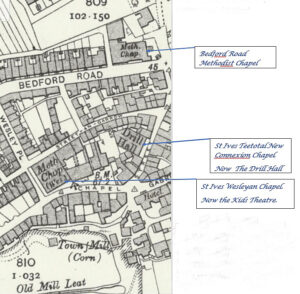
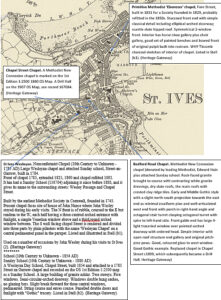
This profile of St Ives Teetotal/New Connexion Chapel , Chapel Street, St Ives, has been compiled by Val Thomas of St Ives Old Cornwall Society.
1743: A 120 strong Methodist Society formed in St Ives.
1743: First visit by Charles Wesley.
August 1743: John Wesley visited St Ives.
1745: John Wesley preached in Street an Garrow which is beside this chapel.
1789: John Wesley preached in the Market Place.
1831: The New Connexion Methodists were a breakaway group from the Wesleyans. They became the Teetotal Wesleyan Methodist who were strictly teetotal. There are several streets in Downlong St Ives with names linking to this period of time. eg. Teetotal Street.
1837: Marriages could be held in the chapels.
1837: ‘Another group of Methodists broke away from the parent Society at St Ives in 1838 on the total abstinence question, and formed a Teetotal Society.’ – Information taken from stayatcohort.co.uk.
1841: ‘One of the biggest splits in the Methodist Church in the 19th Century was on the question of alcohol. The idea of teetotalism (abstinence from alcohol) was controversial but became a strong force within grass roots Methodism on the 1840’s, with the Wesleyan Society not supporting the fast-growing movement. Division occurred throughout the UK, but taking a step further, in St Ives a breakaway group from the St
Ives Wesley Methodist Chapel formed the Teetotal Methodists; who then established the UK’s first Teetotal Society in 1841. It’s first meeting house was in what is now the Drill Hall Arcade. One of the first ministers there was William Booth who went on to form the Salvation Army.’ – Information taken from stayatcohort.co.uk.
 West Briton and Cornwall Advertiser Tuesday 27th May 1843
West Briton and Cornwall Advertiser Tuesday 27th May 1843
1842: ‘The Teetotal Chapel in Chapel Street was opened. They later built chapels at Sheffield, near Paul in
1856 and at Polmanter Water, Halsetown, in 1844. The later reopened in 1878 as St Mary’s Mission
Church.’ Another New Connexion chapel was in Carbis Bay’. – The Book of St Ives – Cyril Noall
1842: The St Ives Teetotal chapel was opened. It was built using the complete plot, edge to edge, with no room for expansion. It had a gallery as shown in the images taken during reconstruction by Brian Stevens. Prior to this building being completed the members had met in a room above a draper’s shop. In the early days men sat on one side of the chapel and women on the other! The chapel had a large vestry and a balcony.
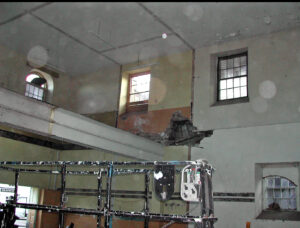
 Balcony images courtesy of Brian and Margaret Stevens.
Balcony images courtesy of Brian and Margaret Stevens.
1860: According to Cyril Noall the circuit joined the New Connexion.
Article in ‘The Cornishman’, Thursday June 19, 1944. Written by Herbert Richards.
“For some years the Teetotal Chapels were unattached to any denomination. In 1860 they approached the Methodist Connexion and joined that body. There was a pamphlet printed in St Ives in 1841 by Mr Kernick and headed/; Rules of the people called Teetotal Methodists. Penzance was in the Penzance Teetotal circuit, the present Alexandra-road Church displacing a room in an old part of town. At one time there was a Teetotal chapel at Lady Downs, near Ding-Dong mine. It is, I think, safe to say that the little Teetotal chapel at Sheffield is the only one in England in which services are held today.
The name of James Teare was so much honoured in West Cornwall at that time that a revered son of Mousehole was named after him. I refer to Mr. James Teare Harry, who was a schoolmaster at Tywardreath for many years.
P.S. – these two chapels have been recently added to the Penzance Circuit Methodist plan.”
 Western Morning News Friday 13th July 1860
Western Morning News Friday 13th July 1860
1861-1862: The Rev William Booth, later General Booth of the Salvation Army conducted a successful ‘revival’ in St Ives. The town had grown to 7,000 and two-thirds of the town were involved in fishing and marketing pilchards. Over 1,000 adults claimed to have been converted including 28 ships captains and 3 mine agents!
1862: ‘The Rev. J. White, Methodist New Connexion Minister of St Ives entertained the members of his classes and other friends at tea in the large vestry of the Wesleyan New Connexion Chapel, after which his friends presented him with an elegent time piece as a mark of esteem and appreciation of his ministerial labours during his two years stay at St Ives’. – The Cornish Telegraph, Wednesday June 4 1862.
1862: The minister of Bedford Road Chapel was Wm. Butterworth.
1871: The Cornish Telegraph, Wednesday September 27 1871 – ‘St Ives in the hands of the Teetotallers at Last! …… it appears that, at St Ives, teetotalism has reduced the public-houses one half, has reformed 100 drunkards, has added 1,500 members to the various Christian churches, and is now about to ‘wield the sword’ to complete the work; which is to return four town councillors triumphantly into the council’.
1875: October. Thomas Jenkyn was appointed as organist.
1875: The 38th anniversary of the St Ives Teetotal Society was celebrated on Monday 31st January. About 60 male members formed a procession, and headed by the volunteer band and interspersed with flags and banners, perambulated the town. A considerable number of persons later sat down to a considerable tea.
Also in Feb 1876 the Trustees of the Methodist New Connexion Chapel, St Ives, having procured an organ, offered their harmonium for sale. It was by Debain, and almost as good as new. Four and a half rows of vibrators; seventeen stops; and two knee-pedals. – Apply to Mr. Henry Daniel, Market {lace, St Ives.
1881: June. A bazaar was held for the repainting of the chapel, this having been completed in a very tasteful manner.
1882 – 1884: Rev. A. Colbeck was the minister. He took a keen interest in the erection of the church in Bedford Road.
1886: Mr Jenkyn, (chemist), who had been the organist for some years resigned in favour of the Wesley chapel organ.
1886: reported 2nd June in the Cornish Telegraph – The Teetotal Society held their 49th anniversary tea on Whit Tuesday. At 7.30 a public prayer meeting was held in the New Connexion Chapel; at 10.30 a procession was formed, headed by a brass band after which a sermon was preached in the chapel. At
2.30pm a procession of members with band, banners and school children again met and perambulated the streets where tea was provided. In the evening a public meeting was held in the chapel when speeches were given. The June parades were held each year according to newspaper reports.
1886: The Cornish Telegraph, Thursday May 17th 1888 ‘The annual festival of the St Ives Teetotal Society, which for 50 years has been held at Whitsuntide, will be abandoned this year. Every year Whitsuntide is becoming more of a general holiday. This has interfered with the success of the festival….’
- Weddings took place in the chapel.
June 1898: The Foundation stones of the new Methodist Connexion Chapel and schools, Bedford Road, were laid.
August the memorial stones and foundation stones of the new school buildings for the Methodist New Connexion were laid by about 50 of the Sunday school scholars on the Thursday afternoon. Some paid £1 and some 10s. This was followed by a procession headed by St Ives Brass Band in the afternoon to Talland where they partook of ‘the cup which cheers.’
 Bedford Road Chapel and Sunday School
Bedford Road Chapel and Sunday School
1899:
Feb 9: 15 scholars entered the Sunday school scholar’s examination. All passed. The senior division was scholars aged 14 – 21 years and they had subjects ‘The origins of sin’, ‘The office and the work of Christ’, and ‘The doctrine of Salvation’. Maggie Stevens was awarded a first-class certificate and Janie Barber a second class. In the lower division prizes were won by Harry Faull Hodge and J. Harold Hodge each gaining 98 out of 100 marks. Honours certificates were given to Eldred Faull, Willie C. Faull with 94 marks. Lydia Berriman, May Prisk, Mary Hodge Luke, Richard Faull Lander, Elvin Comley and Henry Curnow Comley won first class certificates.
April 27: The new Bedford Road chapel was fast approaching completion. ‘The spire has just been fixed.’
August 10: The opening service of the New Methodist Connexion chapel were continued.
The New Connexion chapel closed and was put up for sale. It was at this time that it became known as ‘The Drill Hall’. The congregation had relocated to Bedford Road chapel which was much larger and incorporated a Sunday School as a separate building.
8th July. The chapel, vestries and several nearby properties were put up for auction.
1900: Mr. Edward Hain secured the old chapel premises. The Duke of Cornwall’s Royal Garrison artillery (no 5 Company) used it for their practices. Mr R. S. Read was the nominee for captaincy and there were already 90 volunteers. Dr Palemon Best and Mr T. J. Chellew were lieutenants. The Mayor, Mr Edward Hain had helped to provide the home for the volunteers.
September 26th The report for the opening of the hall was in the Cornish Telegraph. It was known as ‘The
Drill Hall’
The hall was used for various meetings and gatherings over the following years.
1900: August: The Sunday School pupils, accompanied by their pastor, Rev. S. Wright and teachers had their annual tea treat at Carbis Bay.
1900: Mr T. E. Jenkyn was the organist in the new Bedford Road Church.
1901: The Cornish Telegraph, Wednesday February 12 1902. – ‘The St Ives Teetotal Society has existed for 64 years and during that period has done some excellent work. But I am afraid that it has now lost much of its life and vitality. If some of our departed temperance veterans, converts and followers of James Teare were permitted to visit the old town on Feast Monday they would say where is the early morning prayer meeting to ask God’s blessing on the |Society and on the day’s proceedings? Have the members forgotten the divine promise – where two or three are gathered together? Where is the morning sermon? Where are the Temperance people? Where is the good old procession, headed with its banner and marching to the strains of lively music? Where are the children with their smiling happy faces who need to accompany the adults? Where is the public tea which so many used to linger over and talk of ‘the good old times?’ Our old friends would have thought they had been dropped down in the wrong place. This certainly could not be St Ives on Feast Monday!’… etc
1902: Mr Joshua Daniel, who had been pew steward and financial secretary, retired after 23 years.
1902: Feb: The Teetotal Society celebrated its 65th anniversary. They celebrated on St Ives Feast weekend , the first Monday in February, when the Monday is now a local holiday with parades and the silver ball being thrown for the young to play hurling with.
1907: Some of the United Methodist Free Church, The Bible Christians and the Methodist New Connexion joined together to form the ‘United Methodists’. Others merged separately to form the ‘Wesleyan Reform Union.’(West Penwith Resources, Chapels Part 1) 1936. Auctions were held in The Drill Hall.
1946 March: There was a meeting of gunners was held in the Old Drill Hall, St Ives. It was attended by men who had served in the Royal Regiment of artillery in the two world wars, including members of the old No 5 Co. R.G.A.
A carnival queen and two attendants were chosen at the Drill Hall. Miss Phyllis Plummer aged 18 was chosen as queen.
There was a new Drill Hall built at Alexandra Road, Ayr, St Ives.
The Old Drill Hall became home to the R.A.F. cadets who practiced firing there into a target set into a corner.
There were holes in the wall from target practice, taken when it was being reconstructed.
(Photos: courtesy Brian Stevens)
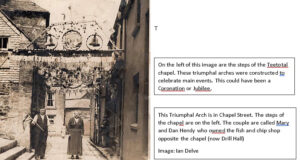
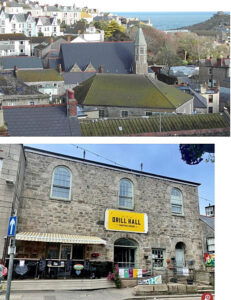 St Ives Teetotal Methodist New Connexion Chapel (Photo: Jo Lewis)
St Ives Teetotal Methodist New Connexion Chapel (Photo: Jo Lewis)
Letter from Brian Stevens. 14 January 2023:
Dear Val
A few notes regarding the former Teetotal Chapel in St. Ives.
This Chaple was presumably built on every square inch of its plot. From the photos you will observe that the overall appearance of the roof is somewhat irregular. It is neither square nor parallel. Also you will detect that there is not any space betwixt the properties on either side for maintenance, except perhaps at its rear.
Photos taken of its interior show windows providing light on its North, East and West sides and with windows both at ground floor level and its upper walls.
The South side has only light from its upper windows.
Concerning the massive Iron Girder that supported its balcony, this was constructed in at least separate six parts. Four of girder and two of iron sheeting. One has gathered over the years that this girder was prepared over to Hayle, most probably at Harvey’s Foundry works. Riveting was the mode of joining together metal items for the mining industry’s demands; this for example engine bobbing beams and their boilers etc.
These girder sections are of two different lengths for the purpose of connecting two at the top and two at the bottom, with the bottom one riveted that is staggered by five or six feet with the top girders then riveted together. So avoiding a vertical line of rivets on each girder. Hence the girder then became to greater strength and the full width of he building, plus the fifteen to eighteen inches that was let into the walls either side for its support. The iron sheeting was also riveted in place between the two girders, (this can be seen when zooming in to the image of the centre of the girder). All this ironwork was then delivered, presumably by vessel or road from Hayle to St. Ives, (The roads at that time were of small stones and rab being as one considers not really capable of conveying such lengths of weighty iron structures in safety, but I have seen photos of ten pairs of horses trundling great hefty items of mine materials to the remote mines of Cornwall. The Victorian era was certainly an age of invention and ‘skeemy’ to convey and erect such work as is still evident today throughout our county.)
With the aid of temporary wooden props for support, these sections were then placed and were riveted in situation by Riveters from Hayle. No mean feat. I take it that the building dates from 1841, so it must had been the Foundry workers, as Harvey’s Ship building yard for iron vessels did not commence that mode of working till at least couple of decades later.
I photographed one particular corner of its interior that showed evidence that rifle shooting practises were carried out in there, this after Bedford Chapel was built and the chapel became redundant. In 1900 an Artillery Volunteer Corp. was formed, and September 1900 they were granted access in the building to hold their practices, mainly during the evenings of the dark winter months. Hence it was then that by the name of Drill Hall this building then became known. In my time the Drill Hall was home to the R A F Air Cadets being principally of young men that practiced there, firing into the target set in that corner. This being proven by the bullet marks, and a certain name and date written in the wall so also confirms. I can remember that until a decade or two back, in passing there on many occasions, hearing the repeated sound of shots being fired.
Please find enclosed reference to this building when the St. Ives Artillery
Volunteer Corp. was active in the town, which I have transcribed.
MINUTE BOOK OF THE ST. IVES “11TH BATTERY DUKE OF CORNWALL’S ARTILLERY VOLUNTEERS” Page 74.
24th September 1900.
REVIVAL AT ST. IVES
Within the past six months a branch of the Artillery Volunteers has been re-established at St. Ives. So successful has been the movement that already there is strength of ninety. Mr. R. S. Read is the nominee for the captaincy, while Dr. P. Best and Mr. T. G. Chellew have been selected for lieutenancies. The premises which until recently, inadequately served as a chapel for the Methodist New Connexion, have been converted into a desirable Drill Hall, and in this endeavour to provide a home for the corps the Mayor (Mr. E. Hain) has proved most helpful. At the opening ceremony on Saturday there was a large gathering of well-wishers, including Lord and Lady St. Levan.
The Mayor, who presided, said there was an attempt to revive the old corps some years ago, but at that time the War Office did not require their services.
Recently, however, that Department had come round to a better frame of mind, and when application was again made for the formation of this company it was acceded to. At the moment the company desired to obtain a drill-hall those former chapel buildings came into his possession, and he was very pleased indeed to place them at the disposal of the committee, to be adapted to their present purpose—(applause).
Brian Stevens, Past Curator of St Ives Museum Margaret Stevens myunitedmethodists.org.uk – Jo Lewis
Kelly’s directories
Find My Past newspaper articles
The Book of St Ives – Cyril Noall
St Ives Museum
The St Ives Times and Echo
